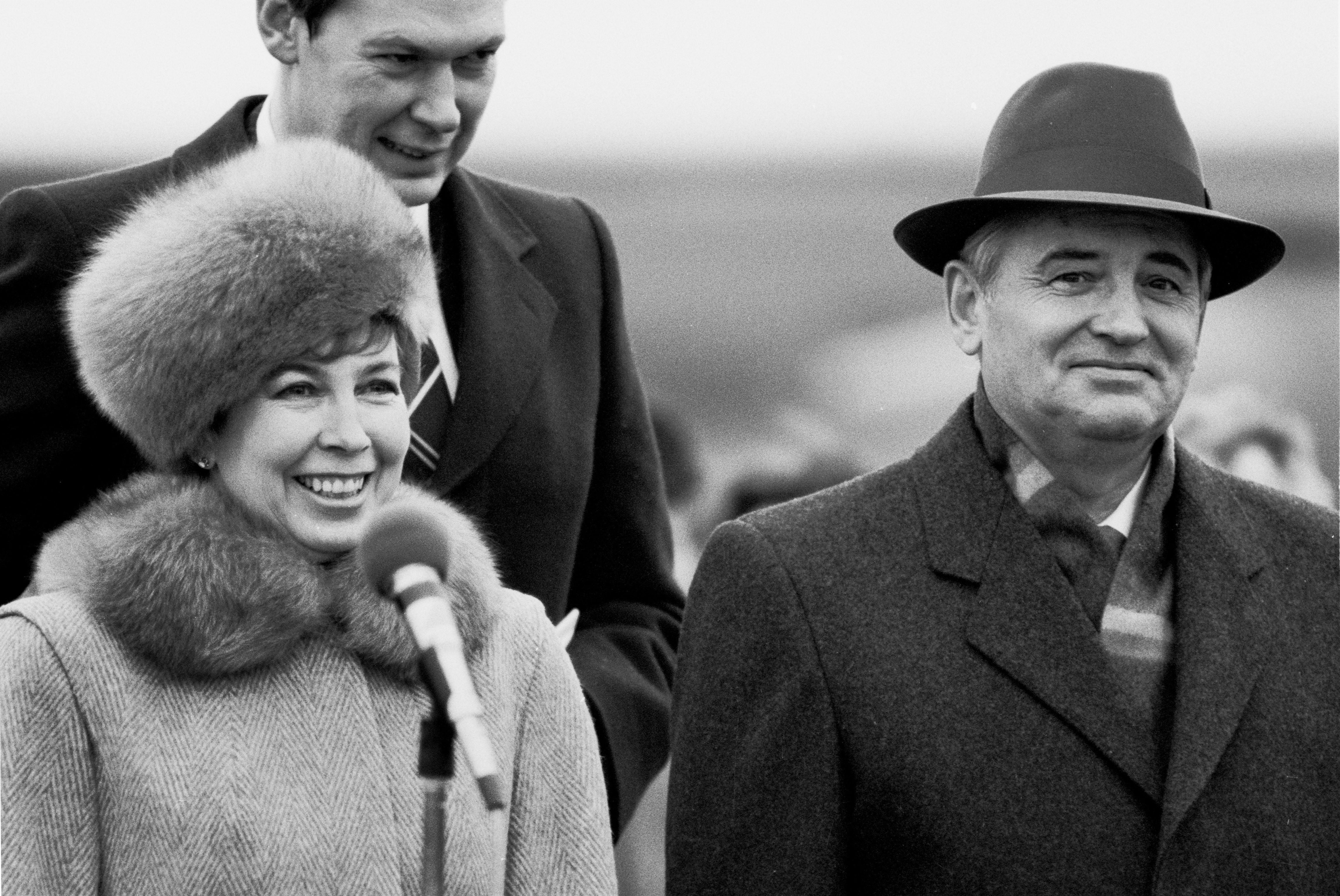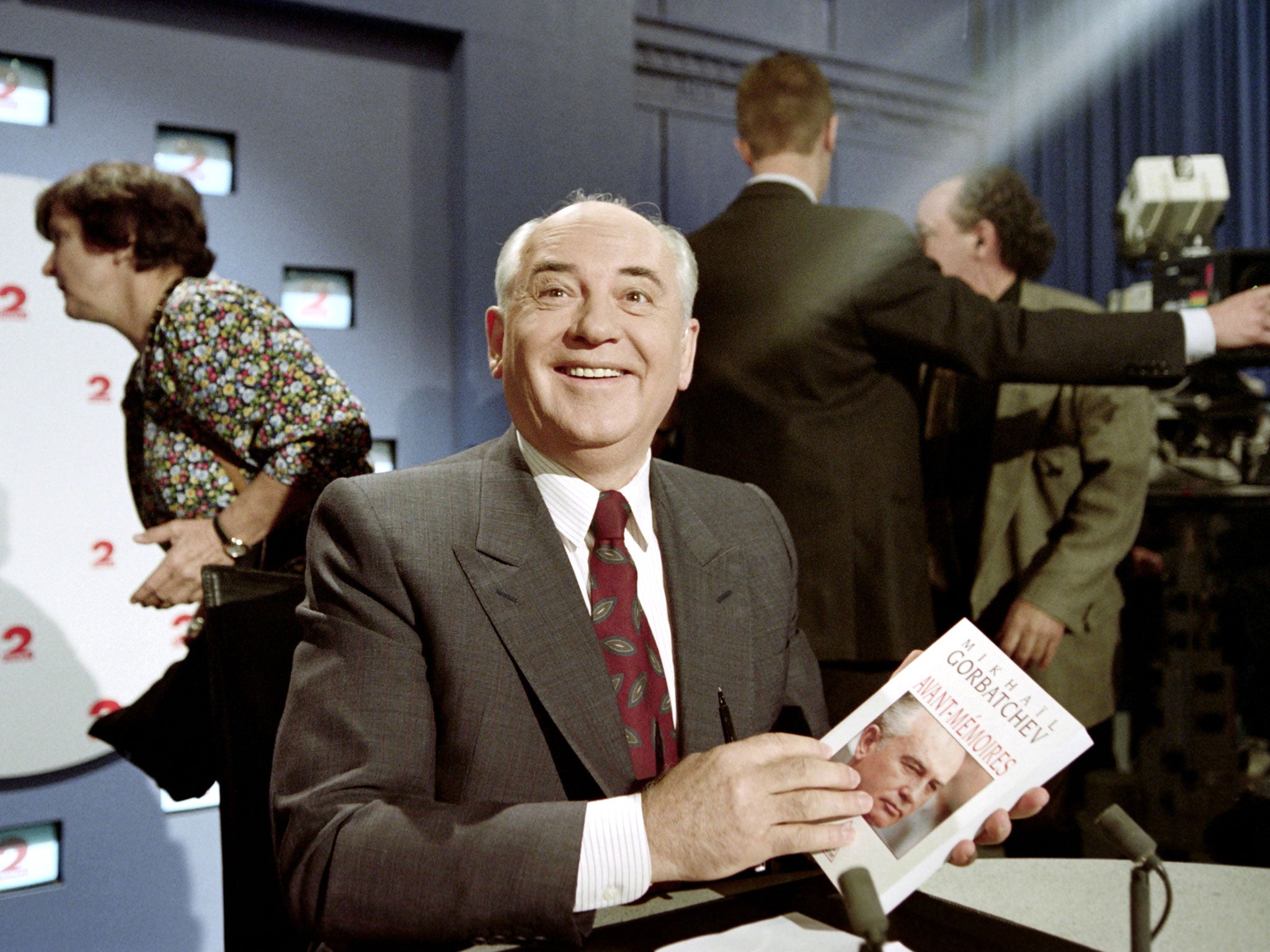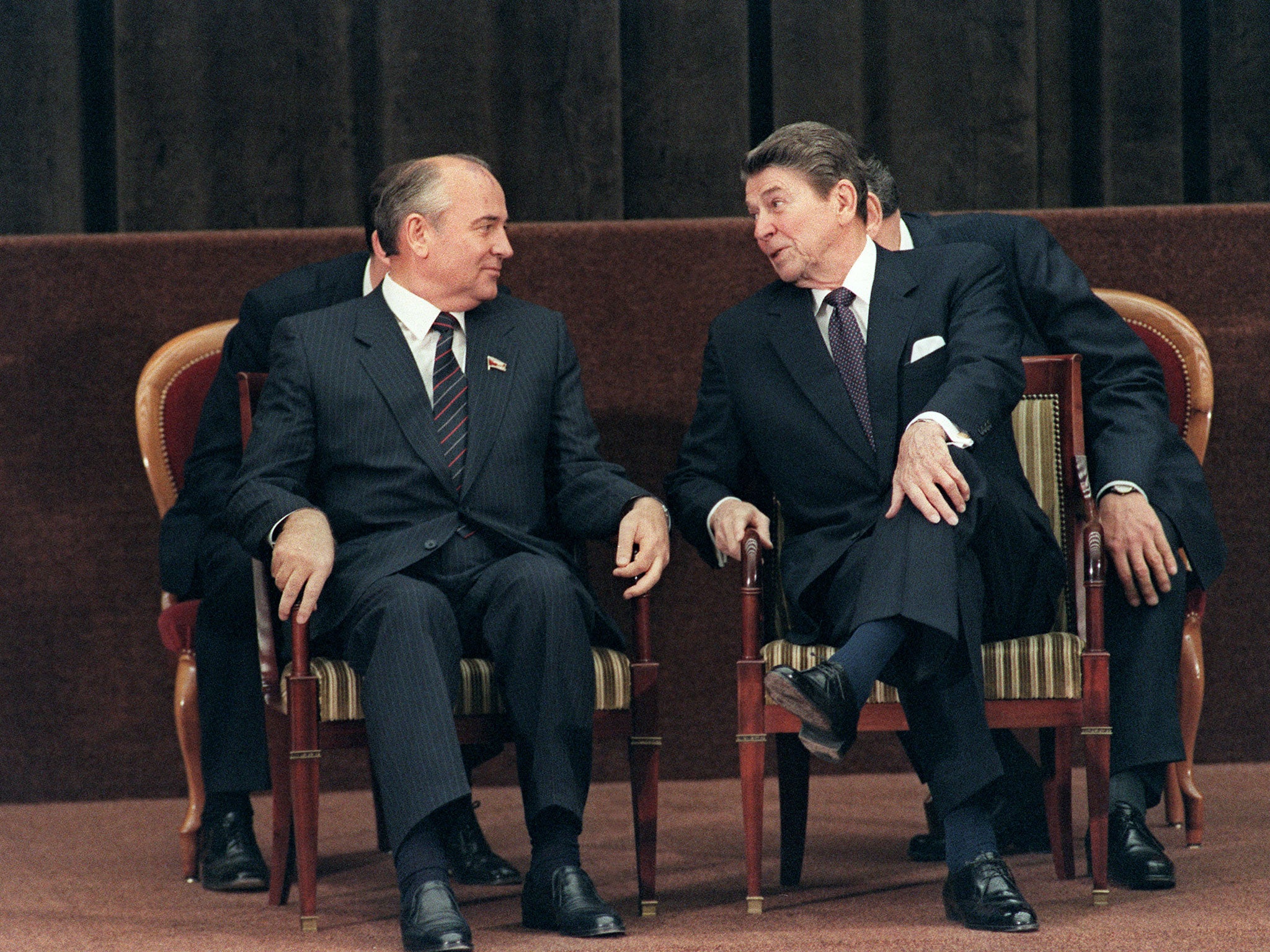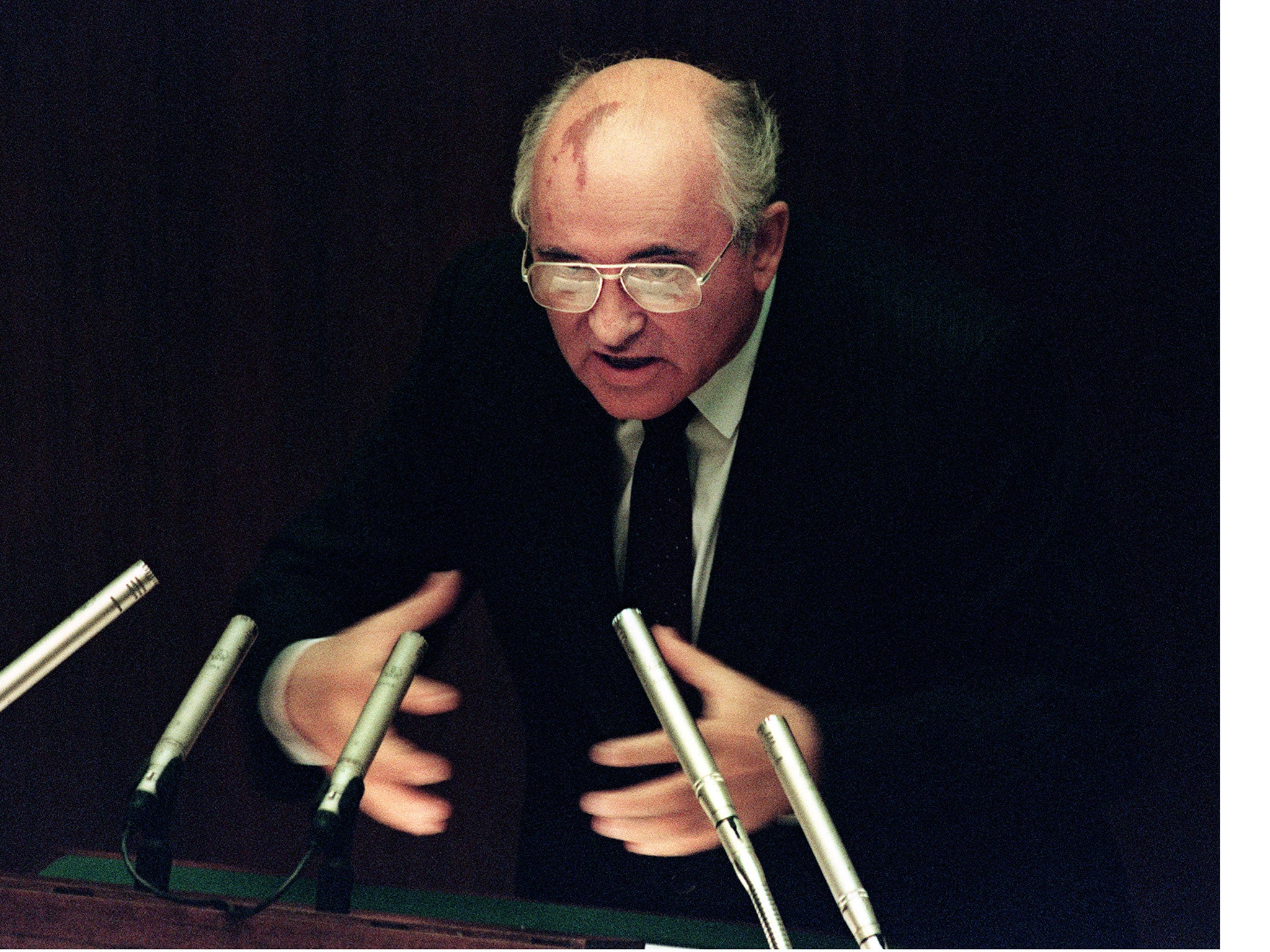Mikhail Gorbachev: Soviet Union’s final president who changed world history
‘An epoch in world history came to an end directly as a result of his actions’

Your support helps us to tell the story
From reproductive rights to climate change to Big Tech, The Independent is on the ground when the story is developing. Whether it's investigating the financials of Elon Musk's pro-Trump PAC or producing our latest documentary, 'The A Word', which shines a light on the American women fighting for reproductive rights, we know how important it is to parse out the facts from the messaging.
At such a critical moment in US history, we need reporters on the ground. Your donation allows us to keep sending journalists to speak to both sides of the story.
The Independent is trusted by Americans across the entire political spectrum. And unlike many other quality news outlets, we choose not to lock Americans out of our reporting and analysis with paywalls. We believe quality journalism should be available to everyone, paid for by those who can afford it.
Your support makes all the difference.One man can change history. Mikhail Gorbachev’s one-time Marxist comrades would dispute that. History is shifted, in the analysis, by great economic forces and class conflicts. But the man who was the last President of the Soviet Union proved them wrong. An epoch in world history came to an end directly as a result of his actions.
On Tuesday night, almost 31 years after the dramatic coup the led to his downfall, MrGorbachev’s extraordinary life came to an end at the age of 91.
It was not his intention to bring about the collapse of one of the great empires of the 20th century. He wanted to reform Russian communism and modernise it – with a speed and scale which startled both friends and foes alike all across the world.
But his efforts to democratise his country’s political system, and decentralise its economy, set in process events which led to the fall of the Berlin Wall, the break-up of the Soviet Union and the collapse of communism as a global force.
He had not begun as a reformer or radical. As a child he experienced the great Soviet famine of 1932-3 in which nearly half the population of his native village, Privolnoye, died. And both of his grandfathers were arrested on false charges, with one of them sent to Siberia where he was tortured and imprisoned. But despite that Gorbachev grew up to be a loyal communist who chose Stalin as his special topic for his final school exams.
As a young man he drove a combine harvester on a state farm for four years but he was bright and went to study law at Moscow University in 1950. There he met the love of his life, Raisa Titarenko, whom he married, and another student who was also to have a pivotal influence on his life. The kindred spirit was a Czech student named Zdenek Mlynar who went on to become one of the architects of the great transformation of his native country, which became known as the Prague Spring.
This Czech experiment to “give socialism a human face” was crushed within months when Warsaw Pact tanks rolled into Prague in August 1968 to quell the uprising. One year later Gorbachev went to Czechoslovakia and – having imbibed the Soviet propaganda about the incident – was shocked to find factory workers turning their back on him and the rest of the official Russian delegation to which he belonged. Their reaction hit him hard. He never forgot the impact that Soviet repression had had.

But in his early years after leaving university Gorbachev was a Communist Party loyalist. His rise in the party was meteoric. By 1960 he was the top official of Komsomol, the Communist Youth Organisation, in his region. Within another decade he was party leader there. One of the youngest provincial party chiefs in the Soviet Union he built a reputation for simultaneously reforming its collective farms and improving conditions for workers.
By 1980, at the age of just 49, he had become the youngest member of the Soviet Politburo. Then, in just three years, three elderly leaders of the Soviet Union– Leonid Brezhnev, Yuri Andropov and then Konstantin Chernenko – died in quick succession. The Politburo voted for youth. In March 1985 Gorbachev became the general secretary of the Communist Party of the Soviet Union – and the first Soviet leader who to be born after the Russian Revolution.
As party leader he immediately set about replacing more conservative members of its Central Committee with younger men who shared his vision of a reform-shaped future.
His country was in a poor state. Its economy was backward. Factories and mines were decrepit and taking their toll on the environment, as the Chernobyl nuclear disaster in 1986 showed. Crime, alcoholism and drugs were out of control in Soviet towns. Social unrest was growing over food shortages. The Soviet occupation of Afghanistan had become Russia’s Vietnam. And the United States was constantly pushing up the cost of the arms race to levels the Soviet economy could not sustain.
Gorbachev’s big vision was that communism and capitalism could work alongside each other inside the Soviet system. He introduced a number of key buzzwords into the world’s vocabulary. “Perestroika” (restructuring) was code for liberalising the economy, encouraging private ownership, modernising technology and increasing worker productivity. “Glasnost” (openness) was about loosening the sclerotic Soviet political structures. “Demokratizatsiya” (democratisation) indicated how the party was to be reformed. And “uskoreniye” (acceleration) indicated the pace at which transformation was to come.

Changes were obvious on all fronts. Dissident intellectuals, like the human rights activist Andrei Sakharov, were brought out of internal exile and allowed to return to Moscow. Thousands of political prisoners were released. The press became less controlled. The secret ballot was introduced to elections in which multi-party candidates were allowed. Gorbachev even admitted that the 1940 Katyn Massacre, in which 25,000 Polish soldiers were executed, was not the work of the Nazis, as Moscow had always claimed, but of Stalin.
Change happened in foreign policy too. A year before he had been elected Soviet leader Gorbachev had undertaken a tour of foreign countries including Belgium, West Germany, Canada and finally, in1984, the United Kingdom, where he met the British prime minister MargaretThatcher. The Conservative leader was much taken with the charismatic Russian, declaring: “I like Mr Gorbachev; we can do business together.”
The mid-1980s was the era in which the arms race at the heart of the Cold War between America and the Soviet Union reached its height. The US president, Ronald Reagan, had declared the Soviet Union, to be an “evil empire” in 1983. He increased US spending on arms, developing a neutron bomb, cruise missiles and a Star Wars defence system using space satellites.
Gorbachev knew that Russia’s tottering economy could not support that kind of expenditure. He determined to reduce Soviet spending on arms and knew that this could only be done by obtaining the agreement of Reagan that America would do the same.
Gorbachev made an extremely bold move, announcing a proposal to eliminate all immediate-range nuclear missiles from Europe – and the abolition of all nuclear weapons by the year 2000
The West did not know how to react. It became obsessed with debates on whether Gorbachev – with his combination of cleverness, modern-mindedness, Slav nationalism, energy, charm, self-assurance and air of competence and confidence – could be trusted. “In Gorbachev we have an entirely different kind of leader in the Soviet Union than we have experienced before,” the US Secretary of State George Shultz said after meetingGorbachev for the first time.
Just one month after coming to power inMarch 1985, Gorbachev announced the suspension of the deployment of Russian intermediate-range missiles in Europe. In November he met Reagan at a summit in Geneva. The two men struck up a personal relationship.
Then in January 1986 Gorbachev made an extremely bold move, announcing a proposal to eliminate all immediate-range nuclear missiles from Europe – and the abolition of all nuclear weapons by the year 2000. Later that year he began withdrawing Soviet troops from Afghanistan.Then in October Gorbachev and Reagan met in Reykjavik in Iceland and, in a private meeting with no advisers present, agreed in principle to remove all such weapons from Europe and to limit the number each held globally to 100 warheads each. The world was shocked, and delighted.
Later Gorbachev disclosed in his memoirs: “I remember during a walk by the villa garden where we met, President Reagan stopped and said, ‘But, listen to me, President Gorbachev. If we were attacked from space, would we come together? Would we unite?’ I answered him, ‘I do not know what you think about it but I propose that we join forces’.”

The two men agreed that a nuclear war could not be won and would not be fought. They exchanged private and frank letters. Reagan was too cautious to agree to Gorbachev’s suggestion on the total elimination of nuclear weapons. But between them the two men dismantled 40 years of Cold War ideology.
The following year Ronald Reagan, on a visit to Berlin, made a speech by the great symbolic barrier between East and West in which he appealed to Gorbachev to “Tear down this wall!”
The year after that, Gorbachev addressed the United Nations and dramatically announced deep unilateral cuts in Soviet military forces in Eastern Europe. By May 1988 Reagan was standing in Red Square, in Moscow declaring that his words about an “evil empire” belonged to a different era. Within another year the Berlin Wall had been knocked down. By 1991 Gorbachev had even dropped his objections to the Star Wars satellite defence programme. It all turned, Reagan later said in his autobiography, not just on a better relationship between two countries but on “a friendship between two men”.
Back home, however, the Soviet leader’s radical reforms were reaping a different harvest. The economic, social and political changes he made were massive. But Gorbachev’s restructurings did not revitalise the Soviet economy. Instead, it took a severe downturn. Severe shortages of meats, sugar and other basic foods led to the reintroduction of wartime-style rationing.

The Communist Party was split on how to respond. The reformers with whom Gorbachev had made alliances urged accelerating the pace of change. Conservative hardliners wanted to slam on the brakes – or even throw reform into reverse. Gorbachev sought to consolidate his power base by making himself the Soviet Union’s first – and, as it turned out, only – executive president.
But the genie Gorbachev had loosened could not be put back in the bottle. As part of his revision of foreign policy he had made it clear that if the countries of eastern Europe, which had been traditionally regarded as Soviet satellites, wanted to undergo their own process of reform Moscow would not object – and would certainly not send in the tanks as had happened in Prague in 1968.
Working with his foreign minister Eduard Shevardnadze he developed what jocularly became known as “the Sinatra doctrine” since each state was to be allowed to “do it their way”.
That, combined with the recent Soviet withdrawal of its forces from Afghanistan, prompted a series of political revolutions across eastern Europe. In June 1989 free elections were held in Poland. They were won by Solidarity, a once-banned trade union; its leader, Lech Walesa, became the first non-Communist president of Poland.
Over the next few months demonstrations followed in one part of the Soviet bloc after another. Communists were removed from power in Hungary, Czechoslovakia, Bulgaria, Romania and East Germany – bringing the fall of the Berlin Wall in November 1989. By the summer of 1990 Gorbachev had agreed to the reunification of East and West Germany. That year Gorbachev was awarded the Nobel Peace Prize.
In all this Gorbachev had not foreseen the downfall of communism. He merely thought he was overseeing its reform into something more dynamic. But he reckoned without the nationalism which was released all across eastern Europe.
It was unleashed too in Russia itself under the prodding of a new leader, Boris Yeltsin, who was once a prominent supporter of Gorbachev but who now began to outpace him in his enthusiasm for transforming the old command economy into a free-market system with a programme of privatisation and deregulation economic shock therapy. He opposed Gorbachev’s plan for a voluntary federation of democratic Soviet nations thinking it would impede reform.
But although he tried to form a new political party he was never again a figure of any consequence in Russian politics
Gorbachev sought to shift slightly to the right to win the support of the conservative hardliners. It cost him the support of allies such as Shevardnadze, who resigned in protest with the stark warning to the Soviet parliament that the “reformers have gone and hidden in the bushes. Dictatorship is coming”.
In fact, with the economy continuing to collapse amid rising public discontent, the response of the conservatives was to attempt to stage a coup against Gorbachev. In August 1991 they put him under house arrest in his country dacha in Crimea. He was freed after just three days but, on his return, Gorbachev found his practical power had ebbed away. It had shifted to Boris Yeltsin, who had stood up to the Army’s tanks and brought about the collapse of the coup.
Yeltsin, who had been elected president of Russia two months earlier, was now in the ascendancy. The Soviet Union disintegrated as its constituent republics became independent nations across eastern Europe. On Christmas Day in 1991 Mikhail Gorbachev resigned his presidency. The Soviet Union was formally dissolved the next day. The day after that, Yeltsin moved into Gorbachev’s office.
Out of office Gorbachev remained an international figure. The year after his fall from grace in Moscow he founded the Gorbachev Foundation, with its headquarters in San Francisco. The year after that he appeared with his daughter in a TV advert for Pizza Hut.
But although he tried to form a new political party – and criticised subsequent Russian leaders Vladimir Putin and Dmitry Medvedev – he was never again a figure of any consequence in Russian politics.
For all that his legacy was enormous. Mikhail Gorbachev may have been a man who failed in his immediate political project. But he changed the face of world history – and changed it for the better.




Join our commenting forum
Join thought-provoking conversations, follow other Independent readers and see their replies
Comments